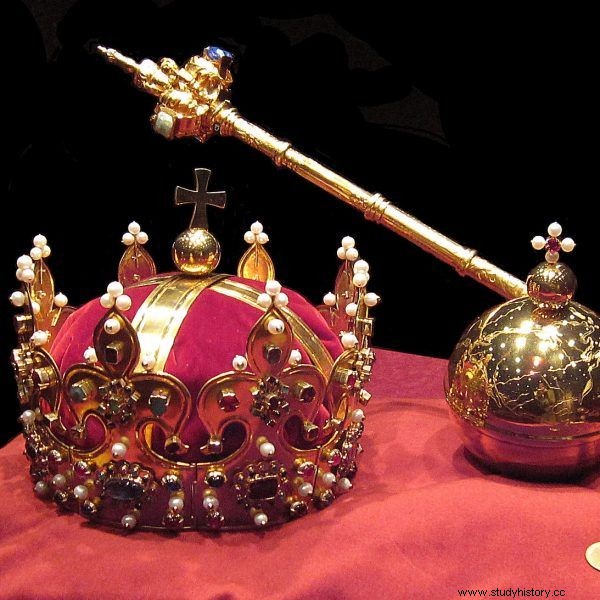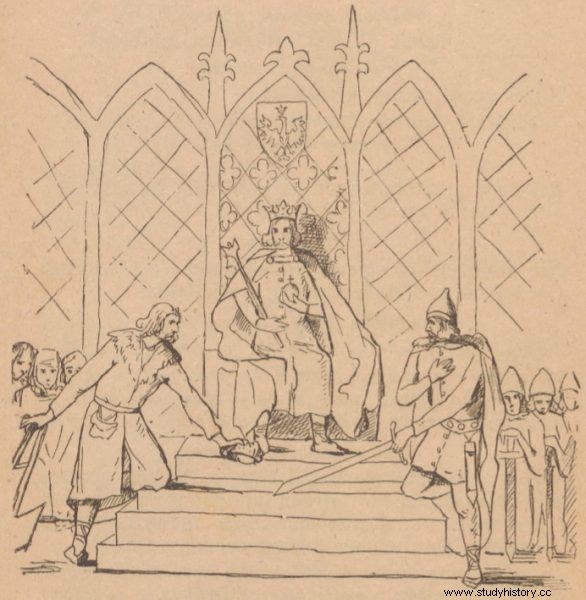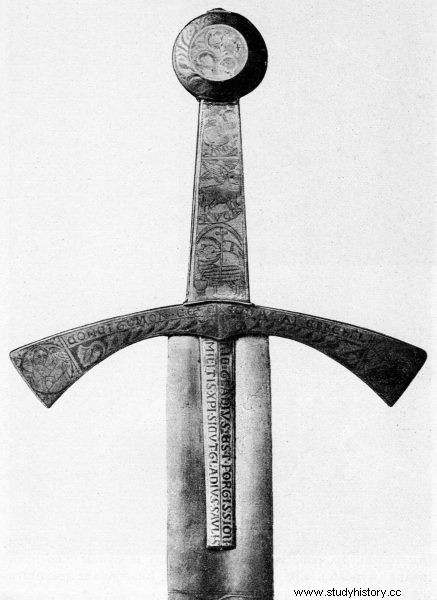On January 20, 1320, Poland became a kingdom again. One of the most unusual celebrations in the history of this place took place in the Krakow cathedral. How exactly did the coronation ceremony of Władysław Łokietek look like?
The temple was not at all bursting at the seams. The notion of crowds of thousands pressing against the monarch, the chaos, crush and stuffiness accompanying the ceremonies of establishing power has little to do with the reality of the fourteenth century.
Also enthusiastic shouts, tears of happiness, faint ladies and crowds chanting with joy should be considered a picture more suited to costume films than to an authentic story.
The coronation - not only in Poland, but actually in every country of Christian Europe - was too important a ritual for its organizers to risk any harm. There could be no spontaneity, unforeseen excesses, or even applause at the wrong moment. The performance was planned in advance and with attention to the smallest details. And the group of guests was screened in such a way that there was no rascal, madman, oppositionist or even a chatter among them.
In France of the same epoch, the huge cathedral of Reims was fenced and rebuilt on the occasion of each coronation. Inside, decorative walls were erected, using them to define a narrow and easy to control space. Only a few hundred of the highest-ranking aristocrats and officials of the kingdom had the right to enter the cathedral during the ceremony. And the temple gates were bolted shut as soon as the ceremony began.
The crowd of the curious remained outside - where his presence did not threaten any image or organizational blame.

Replicas of Polish coronation insignia (photo:Gryffindor; CC ASA 3.0)
Welcome to the new king
The temple on the Wawel hill did not require similar interventions. Its size, very modest for the capital's church, but also overall for the cathedral, imposed the choice of the public, limiting it only to the most dignified persons. The invitation to the ceremony was undoubtedly an act of exaltation. The elite of the elite gathered in the nave. Only people who really had something to say about the fate of the country. The Lord was the last to join them.
He entered through the main faiths, preceded by a solemn procession. Clergymen, equipped with holy books, crucifixes and incense, proceeded in front of the monarch, and at the very door he was solemnly welcomed by the archbishop of Gniezno, Janisław. After entering the walls of the cathedral, Łokietek anointedly put down his weapon and took off his cloak, and then, led by the bishops, he approached the altar to prostrate himself in front of it and, in the position of the highest devotion, to pay solemn homage to God. He only rose from the ground after reciting the full Litany of the Saints.
At this stage, the bishops surrounding the king, who had just laid the cross at his sides, began presenting the candidate to the head of the Polish Church. They emphasized that one, like no other, is worthy to wear a crown and obtain the title of Polish king. After hearing them, the archbishop addressed the elect directly. He asked him a number of questions formulated as if Łokietek was to take over the government and guardianship over the country only after the ceremony was taking place.
Are you going to serve faith? Do you want to protect the Church? Do you want to rule your kingdom fairly and defend it from your enemies? The prince replied in the affirmative three times. After hearing his declaration, the archbishop addressed directly to the assembled people, asking them if they, in turn, wished to serve the new king faithfully. From all throats came a pre-determined exclamation:"Advises, advises, advises!".
Nobody dared to be silent, nobody hesitated. After all, the list of those present was established so that the acclamation, only pretending to be freely elected by a group of subjects, would proceed without the slightest objection.

The interior of the Wawel Cathedral. Graphics from 1877
Formula almost as old as the Piast state
Knowing (and so in advance) God's will expressed through the mouths of the people, the two bishops put mittens on their heads, and then turned to the kneeling candidate for the crown to receive his oaths confirming previously made commitments. When these sounded within the walls of the temple, the choir began singing the litany, and the archbishop plunged into personal prayer. Only when the silence fell again, Janisław began to deliver solemn words of blessing.
It was a formula almost as old as the Piast state. It has been used in Europe since the 10th century and has brought countless kings to sacred power. The archbishop appealed to the Old Testament monarchs; to ideal rulers who care for law, justice and the good of their subjects. His words alone, however, could not yet make Łokietek a full-fledged king. Two church dignitaries left the nave and went to the chapel of Saint Catherine next to the sacristy.
It was there that the sacred oils were stored in a chalice made of gold covered with silk. A short but glittering and anointed procession followed. Under a magnificent canopy, the oils were transferred to the altar, where the archbishop greeted them with a kiss. The hierarch then sat down in an ornate chair, and around it the bishops did the same.

Elbow on the throne. A drawing from the book Łokietek in the Ojców Mountains published in 1918.
A circle was formed, in the center of which the candidate for the crown was still kneeling. The prince was undressed, unbuttoning the cope and the dalmatic, thus revealing the upper part of his body. Janisław moistened the thumb of his right hand, immersing it in a cup of oil, and anointed the elect's breasts, back, and finally arms in one continuous movement.
According to the rite, there was complete silence for a long moment. The gathered people remained silent, while one of the bishops slowly wiped the anointed places with silk, and the archbishop blessed the previously removed ceremonial robes:a cape and a dalmatian, and put them on the ruler's shoulders again.
Finally, from his lips came the words opening the Holy Mass: Adiutorium nostrum in nomine Domini ... So:"Our help in the name of the Lord." The crowd answered loudly, "Who made heaven and earth." Weaving the ceremony of the elevation of the candidate to the throne within the framework of the mass was a peculiarity almost unheard of in the Christian world. A similar ceremony was in place in the few countries that strictly adhered to the Holy See's guidelines for coronation protocols.
Such a solution helped to emphasize that the ruler was no longer a mere mortal at the time of the anointing. He was promoted to the rank of priests, kings and prophets of the Chosen People. And this is why, already during the mass, between the reading and the Gospel, the archbishop proceeded to hand over the king of the coronation insignia.
Signs of lordship. The presentation of the coronation insignia
First, Łokietek was given a sword. And this is a sword that is not accidental, because with its mere presence it emphasizes that the act of coronation was the merit of not only the prince, but also his wife, Jadwiga Kaliska . It was about a blade known today as Szczerbiec and, through a legend, associated with the first Polish king, Bolesław the Brave. In fact, this Szczerbiec was created not in the years of the kingdom's birth, but quite recently, in the middle of the 13th century. Its first owner was the Duke of Greater Poland, Bolesław the Pious. After him, the ceremonial weapon was inherited by his daughter Jadwiga, and then passed it to her husband.
No Christian ruler would be ashamed of such a sword. Szczerbiec was an example of master craftsmanship, both in terms of forging and finishing. The intricate hilt made of gold plates has engravings depicting the Lamb of God and the figures of the evangelists. There are also inscriptions that give the blade not only symbolic, but even magical power. The monogram composed of the letters Alpha and Omega was accompanied by a Latin inscription:"This sign strengthens the love of kings and princes, and the anger of judges."

The famous Szczerbiec was most likely a gift from the royal wife.
On the crossguard, in turn, the Hebrew text:"Fervent faith is awakened by the names of God Sadalai and Ebrahel" and the Latin text:"Whoever wears these names of God with him, no danger will harm him at all."
Elbow-high took from the archbishop a sword, ninety-eight centimeters long and weighing just over a kilogram, and made several ritual cuts with it. At the same time, the crowd sang, "Yours is the power, glory and dominion ...". The sword was quickly placed in the scabbard given to the archbishop so that it would not get stuck at the most important moment of the ceremony.
Janisław and the two bishops assisting him took a crown of pure gold, prepared especially for the occasion, set with rubies, emeralds, sapphires and pearls. A magnificent insignia, adorned with a total of almost five hundred jewels, was placed together on the temples of the ruler. Then they handed him the scepter and the apple of reign. And at that moment, Łokietek turned from a prince into a full-fledged Christian king.
